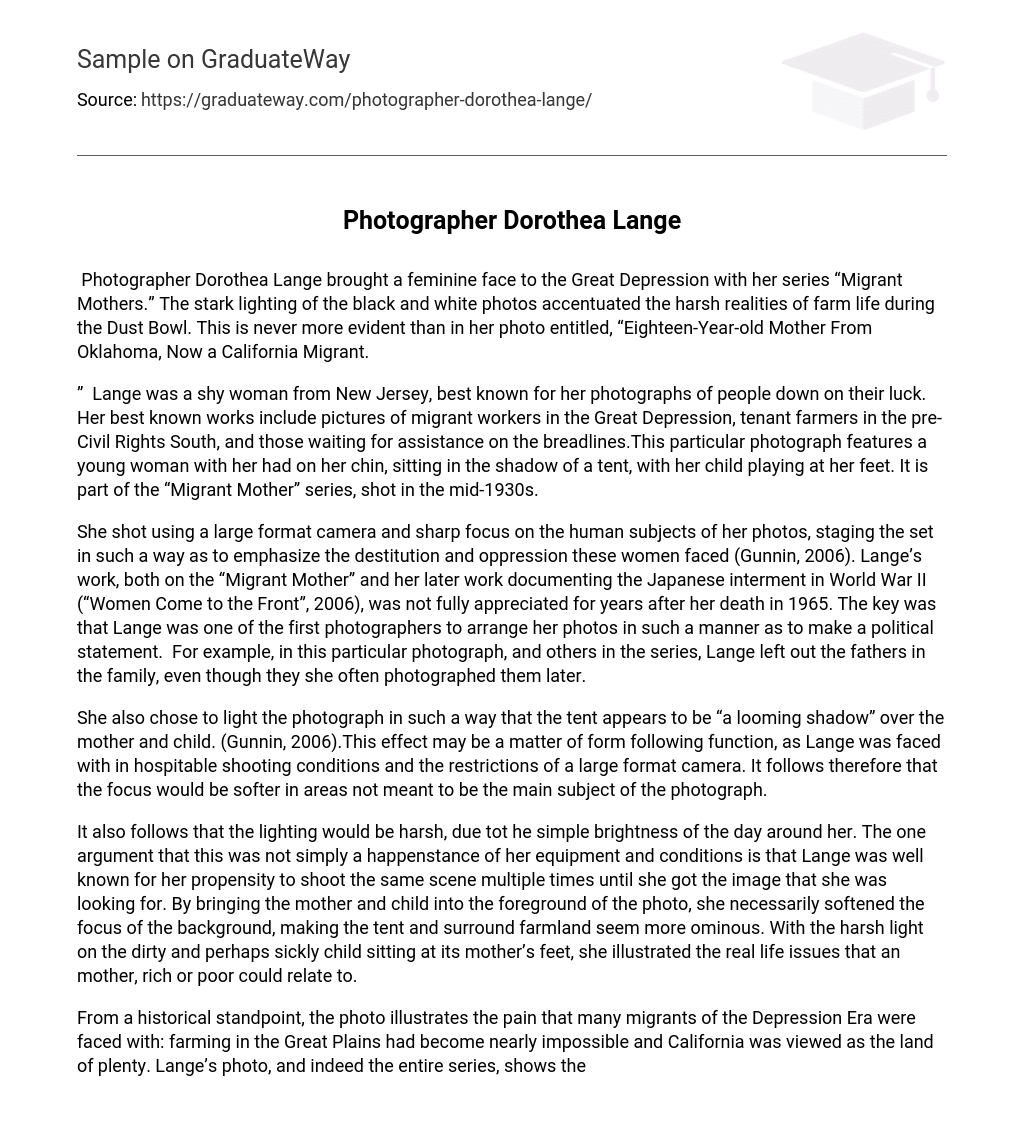Photographer Dorothea Lange brought a feminine face to the Great Depression with her series “Migrant Mothers.” The stark lighting of the black and white photos accentuated the harsh realities of farm life during the Dust Bowl. This is never more evident than in her photo entitled, “Eighteen-Year-old Mother From Oklahoma, Now a California Migrant.
” Lange was a shy woman from New Jersey, best known for her photographs of people down on their luck. Her best known works include pictures of migrant workers in the Great Depression, tenant farmers in the pre-Civil Rights South, and those waiting for assistance on the breadlines.This particular photograph features a young woman with her had on her chin, sitting in the shadow of a tent, with her child playing at her feet. It is part of the “Migrant Mother” series, shot in the mid-1930s.
She shot using a large format camera and sharp focus on the human subjects of her photos, staging the set in such a way as to emphasize the destitution and oppression these women faced (Gunnin, 2006). Lange’s work, both on the “Migrant Mother” and her later work documenting the Japanese interment in World War II (“Women Come to the Front”, 2006), was not fully appreciated for years after her death in 1965. The key was that Lange was one of the first photographers to arrange her photos in such a manner as to make a political statement. For example, in this particular photograph, and others in the series, Lange left out the fathers in the family, even though they she often photographed them later.
She also chose to light the photograph in such a way that the tent appears to be “a looming shadow” over the mother and child. (Gunnin, 2006).This effect may be a matter of form following function, as Lange was faced with in hospitable shooting conditions and the restrictions of a large format camera. It follows therefore that the focus would be softer in areas not meant to be the main subject of the photograph.
It also follows that the lighting would be harsh, due tot he simple brightness of the day around her. The one argument that this was not simply a happenstance of her equipment and conditions is that Lange was well known for her propensity to shoot the same scene multiple times until she got the image that she was looking for. By bringing the mother and child into the foreground of the photo, she necessarily softened the focus of the background, making the tent and surround farmland seem more ominous. With the harsh light on the dirty and perhaps sickly child sitting at its mother’s feet, she illustrated the real life issues that an mother, rich or poor could relate to.
From a historical standpoint, the photo illustrates the pain that many migrants of the Depression Era were faced with: farming in the Great Plains had become nearly impossible and California was viewed as the land of plenty. Lange’s photo, and indeed the entire series, shows the folly in the dream of a better life out west. Lange would continue her social commentary in her later years, as she photographed the ravages of World War II. “To capture the spirit of the camps, Lange created images that frequently juxtapose signs of human courage and dignity with physical evidence of the indignities of incarceration.
” (“Women Come to the Front” 2006). Lange even had her photographs censored by the American government because she so dramatically portrayed the human side of these internment camps. Lange’s impact on photography was that she moved from capturing a particular moment in time, as a photojournalist might, to documenting an era. Though staged, her photos were meant to emphasize and relate to the remainder of the country the hardships facing a particular sub-class.
Lange’s photographs also served other disciplines well, bring sociology into the realm of photography, or vice versa, for the first time. Lange made no effort to claim her photographs were factual from a journalists’ standpoint, but rather that they were representative of an entire era.Lange brought an entirely different perspective to photography and to the imagery of a nation in pain, and later, at war. Though she worked with some of the most prominent photographers of her time, including Ansel Adams, she did not emphasize the beauty and wonderment that others made famous.
Instead, she brought the face of humanity into her photographs, most often through the plight of women. With this photograph “Eighteen-Year-Old Mother From Oklahoma, Now a California Migrant”, Lange demonstrate the psychological and sociological impacts of the Great Depression while still depicting the quiet dignity of those who faced the struggle and won by their very survival. The “Migrant Mothers” series showed more clearly than anything written about the Great Depression the horrors that families migrating to California faced once they arrived.The photograph of Dorothea Lange is important on many levels, not the least of which is the feminine face it put on a national tragedy.
By choosing women and children as her subjects, Lange managed to make them sympathetic subjects and revolting due to their circumstances all at once. Her decisions with the lighting and the placement of her subjects within the frame lead to a stronger emotional impact on everyone concerned and led to her place in art history. She was a pioneer in mixing the sociological commentary with the documentary-style photographs that preceded her.Works Cited Gunnin, Steven “Depression Era Photograph by Dorothea Lange: Eighteen-Year-old Mother From Oklahoma, Now a California Migrant”, www.associatedcontent.com, October 6, 2006. “Women Come to the Front: Journalists, Photographers and Broadcasters During World War II.”, Library of Congress, http://www.loc.gov/exhibits/wcf/images/wcf095_thumb.gif, June 19, 2006.





